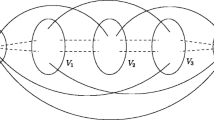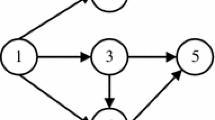Abstract
The network design problem is a well known optimization problem with applications in telecommunication, infrastructure designs and military operations. This paper devises the first formulation and solution methodology for the multi-commodity k-splittable two-edge disjoint survivable network design problem with capacitated edges and relays. This problem realistically portrays telecommunications network design but has not been solved previously due to its computational difficulty. Edge capacity is considered as either a discrete or a continuous variable. An exact method and a practical heuristic method are presented, and computational results are discussed.



Similar content being viewed by others
Explore related subjects
Discover the latest articles, news and stories from top researchers in related subjects.References
Altin, A., Belotti, P., & Pinar, M. C. (2010). OSPF routing with optimal oblivious performance ratio under polyhedral demand uncertainty. Optimization and Engineering, 11(3), 395–422.
Atamturk, A., & Rajan, D. (2002). On splittable and unsplittable flow capacitated network design arc-set polyhedra. Mathematical Programming, 92(2), 315–333.
Atamturk, A., & Rajan, D. (2008). Partition inequalities for capacitated survivable network design based on directed p-cycles. Discrete Optimization, 5(2), 415–433.
Azodolmolky, S., Angelou, M., Tomkos, I., Panayiotou, T., Ellinas, G., & Antoniades, N. (2012). Impairment-aware optical networking: A survey. In N. N. Antoniades, G. Ellinas, & I. Roudas (Eds.), WDM Systems and Networks, Optical Networks (pp. 443–479). New York: Springer.
Azodolmolky, S., Klinkowski, M., Marin, E., Careglio, D., Pareta, J. S., & Tomkos, I. (2009). A survey on physical layer impairments aware routing and wavelength assignment algorithms in optical networks. Computer Networks, 53(7), 926–944.
Beshir, A., Kuipers, F., Orda, A., & Van Mieghem, P. (2012). Survivable routing and regenerator placement in optical networks. In 4th International Congress on Ultra Modern Telecommunications and Control Systems and Workshops (ICUMT) (pp. 684–690).
Cabral, E., Erkut, E., Laporte, G., & Patterson, R. (2007). The network design problem with relays. European Journal of Operational Research, 180(2), 834–844.
Chen, S., Ivana, L., & Raghavan, S. (2010). The regenerator location problem. Networks, 55(3), 205–220.
Cherubini, D., Fanni, A., Mereu, A., Frangioni, A., Murgia, C., Scutella, M., & Zuddas, P. (2011). Linear programming models for traffic engineering in 100% survivable networks under combined IS-IS/OSPF and MPLS-TE. Computers & Operations Research, 38(12), 1805–1815.
Costa, A., Cordeau, J. F., & Gendron, B. (2009). Benders, metric and cutset inequalities for multicommodity capacitated network design. Computational Optimization and Applications, 42(3), 371–392.
Dahl, G., & Stoer, M. (1998). A cutting plane algorithm for multicommodity survivable network design problems. INFORMS Journal on Computing, 10(1), 1–11.
Dey, S. K., & Adhya, A. (2011). Dynamic connection allocation in WDM network with limited grooming and regeneration facilities. High Capacity Optical Networks and Enabling Technologies (HONET), 2011, 65–70.
Frangioni, A., & Gendron, B. (2009). 0–1 reformulations of the multicommodity capacitated network design problem. Discrete Applied Mathematics, 157(6), 1229–1241.
Gagnaire, M., & Zahr, S. (2009). Impairment-aware routing and wavelength assignment in translucent networks: State of the art. IEEE Communications Magazine, 47(5), 55–61.
Garcia-Manrubia, B., Pavon-Marino, P., Aparicio-Pardo, R., Klinkowski, M., & Careglio, D. (2011). Offline impairment-aware RWA and regenerator placement in translucent optical networks. Journal of Lightwave Technology, 29(3), 265–277.
Garg, M., & Smith, J. (2008). Models and algorithms for the design of survivable multicommodity flow networks with general failure scenarios. Omega, 36(6), 1057–1071.
Huang, S., Martel, C., & Mukherjee, B. (2011). Survivable multipath provisioning with differential delay constraint in telecom mesh networks. IEEE/ACM Transactions on Networking, 19(3), 657–669.
Katrinis, K., & Tzanakaki, A. (2011). On the dimensioning of WDM optical networks with impairment-aware regeneration. IEEE/ACM Transactions on Networking, 19(3), 735–746.
Kewcharoenwong, P., & Uster, H. (2014). Benders decomposition algorithms for the fixed-charge relay network design in telecommunications. Telecommunication Systems, 56(4), 441–453.
Klincewicz, J. (2006). Optimization issues in quality of service. In M. Resende & P. Pardalos (Eds.), Handbook of optimization in telecommunications (pp. 435–458). New York: Springer.
Klinkowski, M. (2012). On the effect of regenerator placement on spectrum usage in translucent elastic optical networks. In 14th International Conference on Transparent Optical Networks (ICTON) (pp. 1–6).
Konak, A. (2012). Network design problem with relays: A genetic algorithm with a path-based crossover and a set covering formulation. European Journal of Operational Research, 218(3), 829–837.
Konak, A., Kulturel-Konak, S., & Smith, A. E. (2009). Two-edge disjoint survivable network design problem with relays. In J. Chinneck, B. Kristjansson, & M. Saltzman (Eds.), Operations research and cyber-infrastructure, operations research/computer science interfaces series (Vol. 47, pp. 279–292). New York: Springer.
Laporte, G., & Pascoal, M. M. (2011). Minimum cost path problems with relays. Computers & Operations Research, 38(1), 165–173.
Marin, A. (2005). Formulating and solving splittable capacitated multiple allocation hub location problems. Computers & Operations Research, 32(12), 3093–3109.
Martinelli, F., Andriolli, N., Castoldi, P., & Cerutti, I. (2014). All-optical regenerator placement in WSON. In International Conference on Optical Network Design and Modeling (pp. 299–304).
Martinelli, F., Andriolli, N., Castoldi, P., & Cerutti, I. (2014). Genetic approach for optimizing the placement of all-optical regenerators in WSON. Journal of Optical Communications and Networking, 6(11), 1028–1037.
Pioro, M., Szentesi, A., Harmatos, J., Juttner, A., Gajowniczek, P., & Kozdrowski, S. (2002). On open shortest path first related network optimisation problems. Performance Evaluation, 48(1–4), 201–223.
Rahman, Q., Bandyopadhyay, S., & Aneja, Y. (2015). Optimal regenerator placement in translucent optical networks. Optical Switching and Networking, 15, 134–147.
Rajan, D., & Atamturk, A. (2004). A directed cycle-based column-and-cut generation method for capacitated survivable network design. Networks, 43(4), 201–211.
Ramirez-Marquez, J., Rocco, S., & Claudio, M. (2009). Stochastic network interdiction optimization via capacitated network reliability modeling and probabilistic solution discovery. Reliability Engineering & System Safety, 94(5), 913–921.
Santos, D., de Sousa, A., & Alvelos, F. (2013). A hybrid column generation with GRASP and path relinking for the network load balancing problem. Computers & Operations Research, 40(12), 3147–3158.
Tipper, D. (2014). Resilient network design: Challenges and future directions. Telecommunication Systems, 56(1), 5–16.
Tomaszewski, A. M., Pióro, M., & Zotkiewicz, M. (2010). On the complexity of resilient network design. Networks, 55(2), 108–118.
Truffot, J., & Duhamel, C. (2008). A branch and price algorithm for the \(k\)-splittable maximum flow problem. Discrete Optimization, 5(3), 629–646.
Varvarigos, E., & Christodoulopoulos, K. (2014). Algorithmic aspects in planning fixed and flexible optical networks with emphasis on linear optimization and heuristic techniques. Journal of Lightwave Technology, 32(4), 681–693.
Xu, D., Chiang, M., & Rexford, J. (2007). DEFT: Distributed exponentially-weighted flow splitting. In 26th IEEE International Conference on Computer Communications (INFOCOM 2007) (pp. 71–79).
Xu, J., Chiu, S., & Glover, F. (1997). Tabu search for dynamic routing communications network design. Telecommunication Systems, 8(1), 55–77.
Author information
Authors and Affiliations
Corresponding author
Rights and permissions
About this article
Cite this article
Kabadurmus, O., Smith, A.E. Multi-commodity k-splittable survivable network design problems with relays. Telecommun Syst 62, 123–133 (2016). https://doi.org/10.1007/s11235-015-0067-9
Published:
Issue Date:
DOI: https://doi.org/10.1007/s11235-015-0067-9




